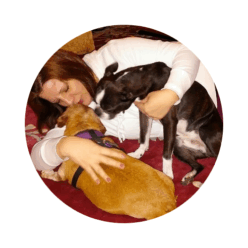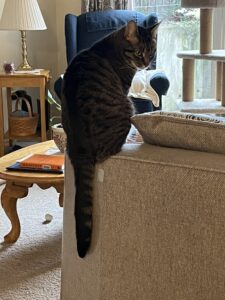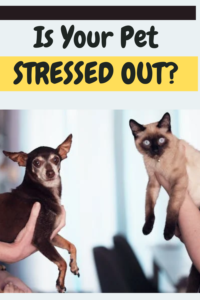Recognizing the subtle hints in your pet’s facial expressions and body language can unlock a whole new world of understanding. With dogs, for example, a relaxed, open mouth might signal contentment, while a tightly closed mouth can indicate discomfort or stress. Cats might squint to show trust, while wide eyes can signal curiosity or fear.
This post contains affiliate links. If you make a purchase, I’ll earn a commission (at no extra cost to you). As an Amazon Associate, I earn from qualifying purchases. I donate 10% of my profits to animal charities.
How to Understand Your Pet’s Body Language
It’s not just about faces, though. Your pet’s ear positions are telling tales too. Dogs with perked ears might be on high alert, whereas pinned-back ears often mean they’re feeling anxious or frightened.
Cats showing similar signs with their ears are offering the same messages. Paying attention to the ears reveals a lot about what your pets are feeling.
A dog with its ears pinned back is likely scared or nervous. A cat with their ears pinned back is likely saying something like, “Get the hell away from me before I scratch your friggin’ face off!’
I’m just sayin’.
And let’s not forget the ever-talkative tail. A wagging tail in dogs is usually a good sign, but the speed and position add context. A slow wag might mean tentative excitement, while a stiff, high tail could indicate dominance or aggression.
A dog wagging its tail doesn’t always mean it’s happy or friendly; sometimes, it can indicate aggression, excitement, or anxiety, and a wagging tail can precede a bite. To understand a dog’s intentions, you have to observe their entire body language and the context of the situation.
Cats with twitching tails could be annoyed or hunting, while a puffed-up tail might mean they’re truly scared. My cat, Whiskers’ tail gets super puffy then he’s scared or when he’s excited.
I think Whiskers’ tail is unusually long and thick. I’ve never had a cat with such a big tail. Have you? That’s him in the picture with his creepy tail lol.
A cat whose tail is twitching can also be a cat getting ready to spray, so look out!
When it comes to body posture, you’re reading a pet’s personal script. A dog with a lowered body might be nervous, while an elevated tail could be showing confidence or even aggression.
Cats arching their backs could be stretching, but when combined with other cues, might mean they’re ready to play or defend themselves.
It’s essential to watch body movement to pick up on your pet’s emotions. A dog wagging everything from their shoulders to their tails is joy personified, while a cat’s gentle kneading could be a sign of affection and comfort.
I don’t know about you, but both those things warm my heart to the moon and back. Seriously.
Gaining insights from these physical cues helps you connect with and respond better to your four-legged friend’s needs.
How to Understand Your Pet’s Emotions
Pets have their own emotional rollercoasters, and recognizing these highs and lows is crucial. Ever notice how your dog gives little leaps of joy when you’re around? Or how your cat curls up quietly when it’s afraid?
Joy, fear, sadness, and excitement are as much a part of their lives as ours.
Playing interactive games can improve your bond and also give insight into what makes your pet tick emotionally. Playtime is more than just fun. It’s an emotional outlet, allowing pets to express happiness, curiosity, and sometimes even frustration.
I knew a guy once who played hide-and-seek with his dog on a regular basis. Too cute! Playing tug-of-war with your dog is also a great way to bond. Make sure you let them win sometimes to build their confidence!
Signs Your Pet is Stressed Out!
Stress signs are often hiding in plain sight, like that slightly droopy walk or sudden withdrawal. Helping your pet cope could involve something as simple as a comfy corner with their favorite toys or reducing sensory overload in busy environments.
Creating a haven goes a long way. Think of it as crafting a stress-free zone for your pet, where they feel loved and safe.
Acknowledging their fears and offering gentle reassurance is key to building a strong emotional foundation between you and your pet.
For help making sure your pets aren’t anxious or stressed out, read these posts:
What is Dog Anxiety? (includes video)
How to Calm Dogs with Anxiety (includes video)
What is Cat Anxiety? (includes video)
Cat Stress Relievers: 10 Things That Stress Your Cat Out! (includes video)
Building a Bond With Your Pet
How to Enhance Communication with Your Pet
Interpreting your pet’s signals starts with sharpening your observation skills. Spend time just watching, picking up on those little quirks and behaviors that are unique to them.
This awareness helps you become their best companion, understanding their needs before they’re even voiced.
Years ago, my sister took care of my two cats, a male and a female, for a few months while I was in a temporary living situation awaiting the move into a house I had purchased.
While they were with her, she said the female cat liked her forehead rubbed, and the male liked his tail gently pulled.
I was shocked. I never knew these things about my beloved cats. I was ashamed of myself for not paying closer attention!
Improving communication is about training too, teaching your pet how to express themselves in ways that make life together smoother. Using consistent commands or signals and rewarding them for communication fosters mutual understanding.
My top recommendation for dog training is The Online Dog Trainer. You can read my complete review of The Online Dog Trainer here or sign up for this free dog training mini course from TrainPetDog.com.
For cat training, I recommend an eBook called, The Complete Cat Training Guide or Cat Clicker Training with Karen Pryor.
Listening to your pet isn’t just responding to barks or meows, but also to the silence and stillness that could mean more than a hundred words. Like when a two-year-old is way too quiet in their room. Mommy knows something’s up!
Or when your pet is usually very active, talkative or playful, and suddenly they’re not.
Being really in tune with their cues makes everyday interactions richer and more meaningful. You can achieve that by spending time with your pet with play and snuggling on a daily basis!
How Do Dogs and Cats Show Love?
You might also like to read my posts talking about the many very sweet and sometimes subtle ways dogs and cats show love. Both include a video!
For more information about understanding your pet’s body language and communication, check out this post from brownswitchpethospital.com, Understanding Your Pet’s Body Language: What They’re Trying to Tell You.
More Help with Pet Care
- Where to Find a Pet - Search Near Your Area
- How to Choose the Right Pet
- Bringing Home a New Pet
- How Often to Bathe Your Pets
- Keeping Pets Entertained While at Work
- Signs Your Pet May Have Separation Anxiety
- Pet Day Care - What You Need to Know
- 6 Myths About Cats and Dogs
- Best Value on Pet Supplies – Save Up to 50% at Pets Warehouse
- Pet Training - My Top Recommendations
- How to Remove Pet Urine Stains from Carpet
- Pet Supplies on eBay – Save a Ton
- Simple Steps to Get Rid of Pet Dander
- Understanding Your Pet’s Body Language and Emotions
- Creative Ways to Celebrate Your Pet’s Birthday
- Fun Activities to Do with Your Pets
- Why Is My Pet So Clingy?
I Donate to Animal Charities
Thank you for visiting my website! I hope this post has helped you learn how to understand your pet’s body language and emotions. It’s a great way to become the best pet owner you can be!
You should know I receive a small commission for some of the products and services I recommend on my site. Visit my home page to see a list of animal charities I donate to.
Please comment below this post if you have any tips you can share with other pet owners about understanding their pet. Thank you! Debra














This article is a great reminder of how much we can learn from our pets’ body language! I never realized how much I could interpret from my cat’s tail movements and ear positions. It’s fascinating to think that by simply observing, we can connect with their emotions on a deeper level. I also love the mention of bonding activities—playing tug-of-war with my dog has definitely helped build trust between us. Does anyone else have a pet with unique body language quirks that they’ve picked up on?
I found the insights on pet body language and emotions truly engaging and thought-provoking. It got me thinking about how to differentiate between similar gestures that might express stress versus excitement. Are there subtle cues or patterns that indicate a pet is feeling overwhelmed, even if the physical behavior seems similar to playfulness? Additionally, in households with multiple pets, how might these signals vary among different species or breeds? I’d love to know if you have any practical tips or personal experiences that have helped refine your understanding of these nuanced behaviors.